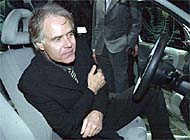Leuenberger opens Geneva motor show with call to cut pollution

The Swiss president, Moritz Leuenberger, has officially opened the 71st Geneva Motor Show by urging car manufacturers to bring more environmentally friendly vehicles on to the market.
In his address on Thursday, Leuenberger – who is also transport and environment minister – said the technology was available for a much cleaner hybrid vehicle, which runs on fuel cells, to be introduced on to the market.
He added that it was up to the automobile industry to push ahead with the vehicles because “the environment is more concerned about exhaust emissions than fancy labels”.
Leuenberger was opening the show at the cavernous Palexpo exhibition centre, where car manufacturers unveiled no fewer than 36 world premieres.
The Geneva event has earned itself a unique place among the top car shows in the world. It may not cover as much surface area as Frankfurt, or receive as many visitors as Tokyo, nor last as long as Paris, but it gets the most media interest, mainly because this is where many manufacturers choose to unveil their latest models.
“The CEO of one company told me that, if the industry had to keep just one car show, it would be Geneva,” Bruno Lurati, the new director of the car show, told swissinfo.
“We give an unique overview on the car industry,” he said. It is for that reason that 5,000 journalists from over 80 countries have descended on Geneva.
Much is made of the fact that, unlike other major car shows, Geneva does not feel it has to favour a national car industry. Consequently, no one firm is given preference.
“It takes place in a neutral market with a wealthy population and good infrastructure,” said Michael Schrimpke, head of public relations for Porsche. He added that despite being a highly competitive place, Geneva has an “almost social atmosphere”.
Geneva’s location means that it is not only Swiss who make the pilgrimage to Palexpo every March. Some 40 per cent of the 700,000 visitors are from abroad. They come to see the kinds of vehicles that would normally be unattainable as well as to see the latest in car design and technology.
While many of the 50 world and European premieres being unveiled in Geneva this week are simply new versions of existing models, there are several brand new cars being unveiled. These include the X-type Jaguar, the Fiat Stilo, the Lancia Thesis and the Renault Vel Satis.
To a certain extent, these vehicles reflect the changing priorities of the motor industry, with style and glamour giving way to technical advances. It is for that reason that the slogan of this year’s car fair is “Headlights on Innovation”.
“The industry has learned that engineering and technical improvements – cutting fuel consumption and improving safety – are the key to success,” Lurati said.
“Of course the car is still sexy. People love cars. But the emphasis is now firmly on technical development,” he told swissinfo.
Despite the lack of an indigenous motor manufacturing industry, Switzerland is always among the first countries to see these technical innovations: “Switzerland has always been one of the most important test markets for the motor industry,” said Bruno Lurati.
“We always have a lot of concept cars tested in Geneva,” he added, pointing to the fact that the car which had just won the show’s cabriolet of the year, the Peugeot 206, had been presented as a concept car at the fair three years ago.
The motor industry is increasingly criticised about the harm cars do to the environment and one of the recurring themes at the fair is the struggle to develop cars which use less fuel. But these models – the Volkswagen Lupo, the Open Astra Eco4, the Toyota Prius and the Honda Insight – are often much more expensive than their petrol-driven equivalents.
“Environmental concerns are omnipresent. Virtually every brand is concerned with cutting fuel consumption,” said Lurati.
“In Switzerland, car importers are under pressure to prove that they are doing something to protect the environment. But a tremendous amount of money is being invested to cut harmful exhaust gases,” he added.
There is already a great deal of excitement surrounding a number of new cars on show in Geneva which are getting a great deal of attention, from the sumptuous Aston Martin Vanquish to the sporty open-top Smart Crossblade, and the new 4X4s from Volvo and Ford to the Nissan Z.
As well as being a showcase for innovation, Geneva is also an important shop window, especially for the more prestigious marques.
“Our primary aim is to raise the profile and sharpen the image of the brand,” said Stefan Brungs, managing director of Rolls Royce-Bentley in Europe. “But since we have the public here in great numbers, that does have commercial implications. We do sell a number of cars during the show.”
Many of the visitors to Geneva between now and March 11 will never be able to afford a Bentley or Rolls Royce. But being able to get close to one is part of Geneva’s attraction.
“The car remains a dream and our show makes the dream come closer,” Lurati said.
by Roy Probert

In compliance with the JTI standards
More: SWI swissinfo.ch certified by the Journalism Trust Initiative
You can find an overview of ongoing debates with our journalists here . Please join us!
If you want to start a conversation about a topic raised in this article or want to report factual errors, email us at english@swissinfo.ch.